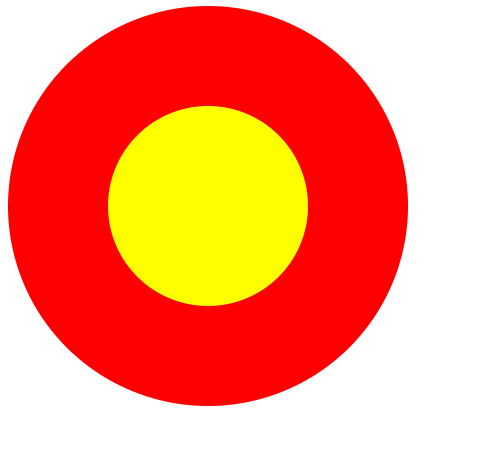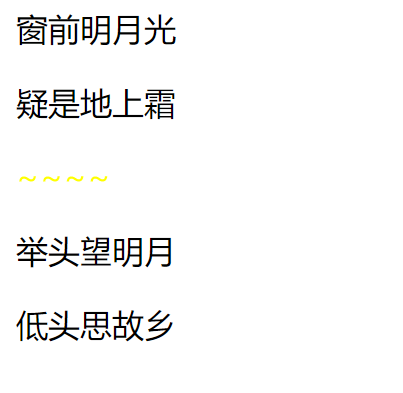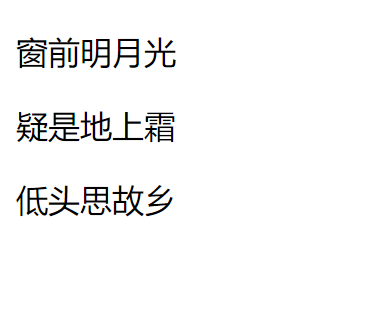首先需要下载安装d3.js : yarn add d3
然后在组建中引入 : import * as d3 from 'd3'
然后定义一个方法,在componentDidMount()这个钩子函数中调用即可。
然后如何绘制一个矢量图 :
1 render() {
2 return (
3 <div id="drawSVG" ></div>
4 );
5 }
先定义一个id为drawSVG的div标签。然后写一个方法,来在这个div中绘制矢量图。
1 oneMethod() { //定义一个方法 2 var width = 400; //定义svg的宽度 3 var height = 400; //定义svg的高度 4 var svg = d3.select("#drawSVG") //选择容器 5 .append('svg') //将svg放入容器里面 6 .attr("width", width) //设置svg的宽度 7 .attr("height", height) //设置svg的高度 8 .style("background-color", "red") //设置svg的背景颜色 9 .style("border-radius", "50%") //设置svg的圆角 10 11 12 svg.append("circle") //在<svg>中添加<circle>标签 13 .attr("cx", "200px") //设置圆形的x坐标 14 .attr("cy", "200px") //设置圆形的y坐标 15 .attr("r", "100px") //设置圆形的半径 16 .attr("fill", "yellow") //设置圆形的填充色 17 }
然后在componentDidMount()中调用。
1 componentDidMount() { 2 this.oneMethod() 3 }
最后来看看会显示出什么样的矢量图行呢。。。

全部代码 :
1 import React, { Component } from 'react';
2 import * as d3 from 'd3';
3 class Demo extends Component {
4 constructor(props) {
5 super(props);
6 this.state = {}
7 }
8
9 componentDidMount() {
10 this.oneMethod()
11 }
12
13 oneMethod() { //定义一个方法
14 var width = 400; //定义svg的宽度
15 var height = 400; //定义svg的高度
16 var svg = d3.select("#drawSVG") //选择容器
17 .append('svg') //将svg放入容器里面
18 .attr("width", width) //设置svg的宽度
19 .attr("height", height) //设置svg的高度
20 .style("background-color", "red") //设置svg的背景颜色
21 .style("border-radius", "50%") //设置svg的圆角
22
23
24 svg.append("circle") //在<svg>中添加<circle>标签
25 .attr("cx", "200px") //设置圆形的x坐标
26 .attr("cy", "200px") //设置圆形的y坐标
27 .attr("r", "100px") //设置圆形的半径
28 .attr("fill", "yellow") //设置圆形的填充色
29 }
30
31
32
33
34
35 render() {
36 return (
37 <div id="drawSVG" ></div>
38 );
39 }
40 }
41
42 export default Demo;
什么是选择集 :
d3.select和d3.selectAll返回的对象称为选择集(selection), 添加、删除、设定网页中的元素, 都得使用选择集.
详解select与selectAll:
1 selsect : 返回匹配选择器的第一个元素 2 d3.select("body") //选择body元素 3 d3.select("#drawSVG") //选择id为drawSVG的元素 4 d3.select(".xxx") //选择class为xxx的第一个元素 5 6 selectAll: 返回匹配选择器的所有元素 7 d3.selectAll("p") //选择所有的p元素 8 d3.selectAll(".xxx") //选择class为xxx的所有元素 9 d3.selectAll("ul li") //选择ul中所有的li元素
查看选择集的状态有三个函数 :
1 查看选择集的状态,有三个函数 : 2 selection.empty() : 如果选择集为空,则返回true。如果不为空,返回false; 3 selection.node() : 返回第一个非空元素,如果选择集为空,返回null; 4 selection.size() : 返回选择集中的元素个数;
举例子 :
1 render() {
2 return (
3 <div id="drawSVG" >
4 <p>窗前明月光</p>
5 <p>疑是地上霜</p>
6 <p>举头望明月</p>
7 <p>低头思故乡</p>
8 </div>
9 );
10 }
1 oneMethodAgain(){
2 var paragraphs = d3.selectAll("p")
3 console.log(paragraphs.empty()) //false
4 console.log(paragraphs.node()) //<p>窗前明月光</p>
5 console.log(paragraphs.size()) //4
6 }
以上就是查看选择集的状态。
对于选择集如何添加、插入和删除元素 :
1 对于选择集 , 添加、插入和删除元素 :
2 selection.append(name) :
3 在选择集的末尾添加一个元素,name为元素名称。
4 selection.insert(name,[,before]) :
5 在选择集中的指定元素之前插入一个元素,name是被插入的元素名称,before是css选择器名称。
6 selection.remove() :
7 删除选择集中的元素。
举例子 :
1 render() {
2 return (
3 <div id="drawSVG" >
4 <p>窗前明月光</p>
5 <p>疑是地上霜</p>
6 <p id="plane" >举头望明月</p>
7 <p>低头思故乡</p>
8 </div>
9 );
10 }
还是这些内容来举例 。
1 oneMethodAgains() {
2 var body = d3.select("#drawSVG")
3
4
5 //在id为drawSVG的div中的最末尾添加一个p元素
6 body.append("p")
7 .text("静夜思")//内容
8 .style("color", "red")//字体颜色
9
10 //在id为plane的p元素前添加一个p元素
11 body.insert("p", "#plane")
12 .text("~~~~") //内容
13 .style("color", "yellow") //字体颜色
14
15 //删除id为plane的元素
16 var plane = d3.select("#plane")
17
18 plane.remove()
19
20 }
显示效果分别为 :



如何设定和获取属性 :
1 设定和获取属性 :
2 selection.attr(name[,value]) :
3 设置或获取选择集的属性,name是属性名称,value是属性值。如果省略value,则返回当前的属性值。
4 selection.classed(name[,value]) :
5 设定或获取选择集的css类,name是类名,value是一个布尔值。表示是否开启。
6 d3.select("p")
7 .classed("xxx",true) //开启xxx类
8 .classed("sss",false) //不开启sss类
9 selection.style(name[,value[,priority]]) :
10 设定或获取选择集的样式,name是样式名,value是样式值;
11 selection.property(name[,value]) :
12 设定或获取选择集的属性,name是属性名,value是属性值。如果省略value,则返回属性名。
13 有部分属性不能用attr()设定和获取,最经典的是文本输入框的value属性,此属性不会再标签中显示。
14 selection.text([value]) :
15 设定或获取选择集的文本内容,如果省略value,则返回当前的文本内容。文本内容相当于DOM的innerText,不包括元素内部的标签。
16 selection.html([value]) :
17 设定或获取选择集的内部HTML内容,相当于DOM的innerHTML。包括元素内部的标签。
这里就不给大家举例子了,大家有时间可以自己试一下。
希望可以帮到大家~ 谢谢。